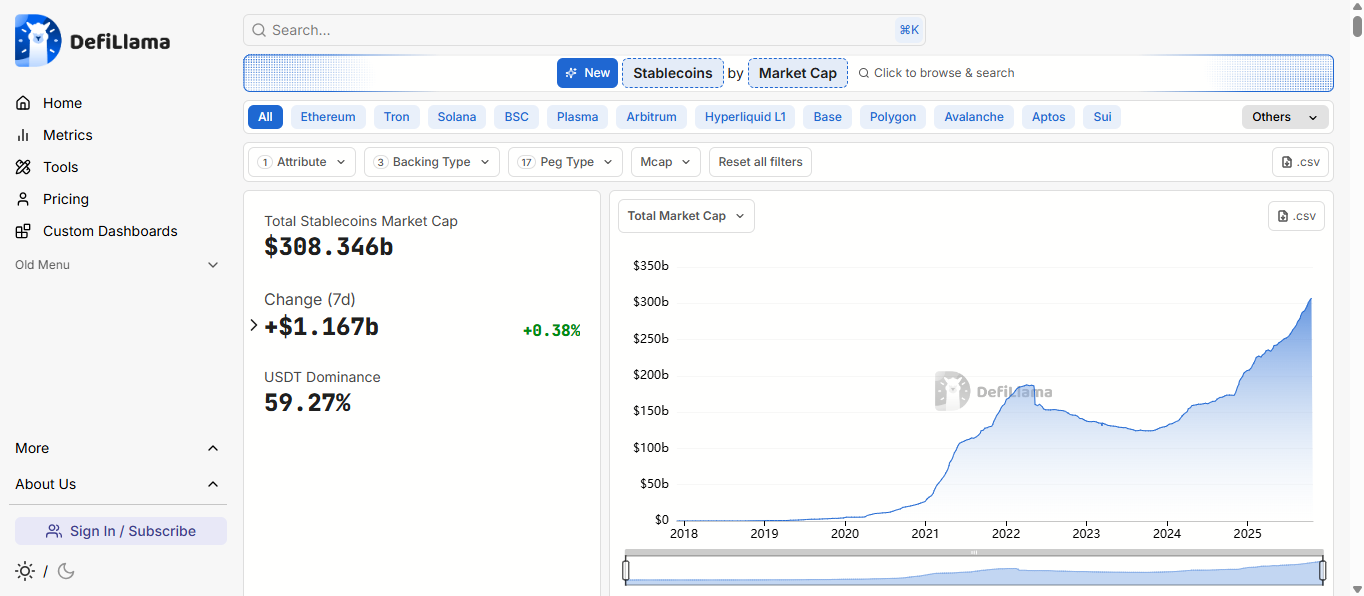TL;DR
- Tether projects a record-breaking $15 billion profit for 2025, up from $13 billion last year.
- USDt remains the largest stablecoin, now circulating nearly $186 billion.
- CEO Paolo Ardoino says "an enormous amount of companies" want to invest.
- Global stablecoin adoption crosses 300 billion market cap, reaching 6.25% of the world's population.
- The growth coincides with the U.S. GENIUS Act, providing the first national stablecoin framework.
Tether, the company behind the world's most widely used stablecoin USDt, expects 2025 to be its most profitable year yet. According to Bloomberg, the El Salvador-based issuer projects around $15 billion in profit, extending its reign as the most profitable entity in the crypto sector - and one of the most lucrative globally on a per-employee basis.
The figure marks a jump from $13 billion in 2024, reinforcing the resilience of Tether's business model amid changing market dynamics and tightening regulations. CEO Paolo Ardoino told Bloomberg that institutional interest has surged alongside the stablecoin's mainstream acceptance.
A Business Built on Digital Dollars
Tether's core product - the USDt stablecoin - continues to dominate the market with roughly $186 billion in circulation, according to data tracked by DeFiLlama.
Stablecoins like USDt serve as digital equivalents of the U.S. dollar, offering users the ability to transfer, trade, and store value globally without the volatility of traditional crypto assets. What makes Tether's model stand out is its simplicity: every token represents a U.S. dollar-denominated reserve, and the company earns significant revenue from interest on those reserves, typically held in short-term U.S. Treasuries.
This interest income has ballooned as global rates remain elevated, effectively turning Tether into a financial powerhouse. On an annualized basis, its profits rival those of major Wall Street firms - achieved with a fraction of their workforce.
Stablecoin Adoption Reaches Record Levels
The explosive growth in stablecoin usage underpins Tether's financial success. In 2025 alone, the total stablecoin market has swelled to over $300 billion , with USDt commanding the lion's share.

Part of that expansion comes from regulatory clarity - particularly the GENIUS Act, the first federal legislation in the U.S. governing stablecoins. The act has been hailed as a milestone, signaling that Washington views blockchain-based dollars not as threats but as tools to strengthen the global reach of the U.S. dollar.
This legal clarity has accelerated institutional adoption, especially among fintech companies and cross-border payment providers that rely on stablecoins for faster settlements.
Ardoino emphasized that Tether's reach now extends to billions of people worldwide.
He noted that USDt has already touched about 6.25% of the global population, underscoring how digital dollars are becoming part of everyday economic life.
Why Tether Keeps Winning
Critics often point to Tether's opaque reserve disclosures, but the company's ability to maintain its peg and scale profitably has consistently silenced skeptics.
Over the past two years, Tether has leaned into transparency by publishing quarterly attestation reports verified by independent auditors. Its growing surplus reserves - now estimated to exceed $10 billion - offer additional confidence that USDt can withstand market shocks.
At the same time, Tether has diversified its operations, channeling profits into areas like renewable energy, AI infrastructure, and payment networks in emerging economies. These investments are designed to reduce long-term risk while expanding utility beyond speculation.
In many ways, Tether has evolved from a crypto liquidity engine into a borderless financial platform, offering stability where traditional systems falter.
The Broader Implications
Tether's record profitability comes amid a pivotal moment for the global stablecoin ecosystem. The surge in digital dollar use has redefined how emerging markets interact with the global economy. In regions facing inflation, USDt often functions as a lifeline for savings and commerce, bridging the gap between local currencies and global finance.
For regulators, the trend poses a paradox: Tether and its peers help stabilize crypto markets - yet their scale challenges the conventional banking system's influence over money creation. The GENIUS Act is an early attempt to balance that tension, framing stablecoins as a regulated extension of U.S. financial infrastructure rather than a rogue alternative.
If successful, it could cement America's digital currency leadership and indirectly amplify Tether's market share - even as competition from Circle's USDC and upcoming central bank digital currencies (CBDCs) intensifies.
What Comes Next
With profits soaring and demand at record highs, Tether's next challenge may not be expansion - but sustainability. Analysts suggest that maintaining such margins will depend on interest rate policy and continued trust in reserve transparency. A global shift toward lower rates could narrow Tether's yield spread, trimming profits even if circulation remains strong.
Still, Ardoino's focus remains on long-term positioning. Tether's combination of operational efficiency, global reach, and diversified investments makes it a uniquely profitable entity - and one that shows little sign of slowing down.
Final Thought
Tether's rise tells a simple story: stability sells. As the world experiments with digital finance, USDt has become a bridge between crypto speculation and real-world money.
Whether driven by remittances, traders, or global merchants, the trend points to a new financial order where trust moves at blockchain speed - and Tether, once a niche crypto tool, now stands at the center of that evolution.
READ MORE : COTI V2’s Secret Weapon: Garbled Circuits Explained for the Web3 Era











